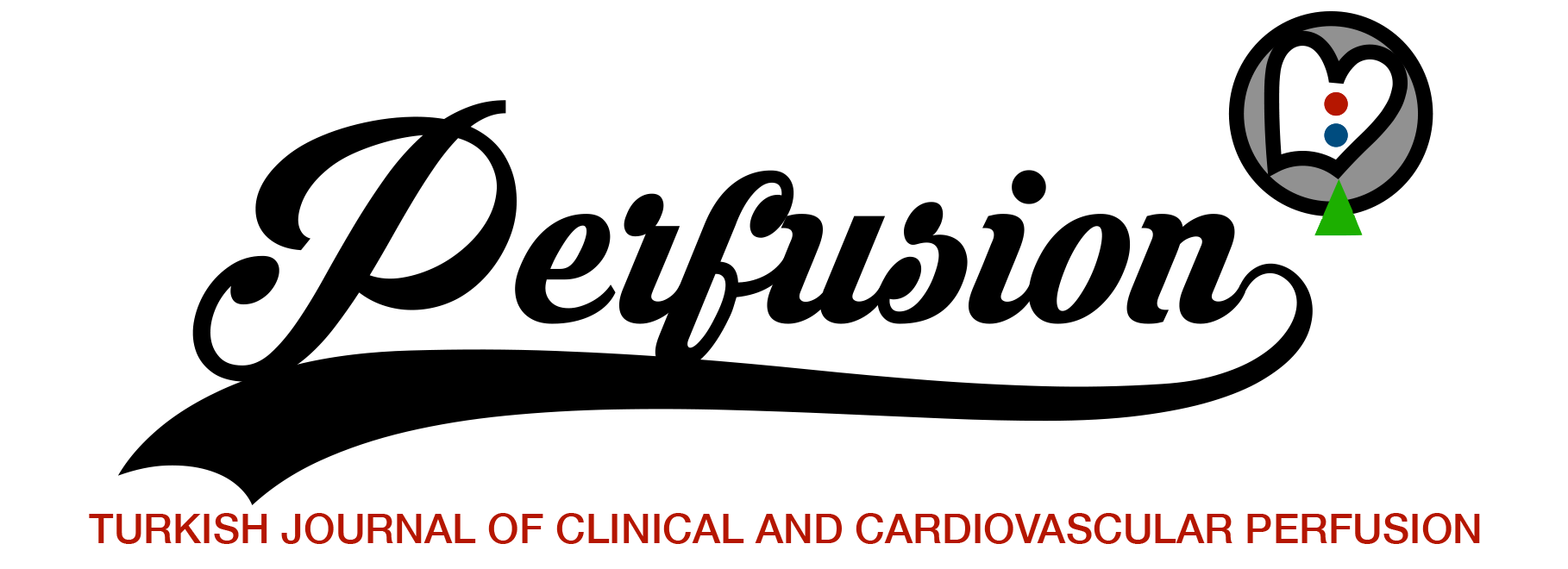ABSTRACT
Objective:
Today, different preventive methods have been developed for myocardial dysfunction in patients undergoing coronary artery bypass graft (CABG) surgery, especially in the postoperative period. One of the most commonly used methods among these is the application of hypothermia during the aortic cross clamp.
Materials and Methods:
A total of 30 patients who underwent coronary bypass surgery under elective conditions under mild hypothermic and normothermic cardiopulmonary bypass in the Cardiovascular Surgery clinic of Private Çorlu Reyap Hospital were included in the study with their consent. Thirty patients who had CABG operation were evaluated retrospectively in 2 groups as normothermic (n=15) and hypothermic (n=15). Mild hypothermia was applied to half of the patients during aortic cross-clamping. The other half of the patients underwent normothermia during aortic cross clamping. The effect of cardiac normothermia on postoperative serum parameters (leukocyte, thrombocyte and hemoglobin counts were taken and activated coagulation time was measured, aspartate aminotransferase, alanine aminotransferase, creatinine, urea, C-reactive protein values from biochemistry samples were examined), blood product replacement amount (fresh frozen plasma and erythrocyte suspension) and the amount of drainage were examined.
Results:
In patients who underwent isolated primary coronary bypass surgery in our clinic, the inflammatory response was lower in the cardiac mild hypothermia group than in the cardiac normothermia group, although it was not statistically significant. However, the results were not statistically significant in serum parameters between groups. At the same time, statistically significantly less drainage was detected in the mild hypothermia group than in the normothermia group. The result was not significant in terms of blood product replacement amount.
Conclusion:
As a result, in elective conditions, there is no big difference between normothermic cardiopulmonary bypass and mild hypothermic cardiopulmonary bypass in terms of postoperative serum parameters and blood product replacement amount, but mild hypothermia is safer in terms of drainage amount.
Keywords:
Hypothermia, cardiopulmonary bypass, coronary artery bypass, normothermia
References
1Bigelow WG, Lindsay WK, Greenwood WF. Hypothermia; its possible role in cardiac surgery: an investigation of factors governing survival in dogs at low body temperatures. Ann Surg 1950;132(5):849-866.
2Shumway NE, Lower RR, Stofer RC. Selective hypothermia of the heart in anoxic cardiac arrest. Surg Gynecol Obstet 1959;109:750-754.
3Martin DR, Scott DF, Downes GL, Belzer FO. Primary cause of unsuccessful liver and heart preservation: cold sensitivity of the ATPase system. Ann Surg 1972;175(1):111-117.
4McMurchie EJ, Raison JK, Cairncross KD. Temperature-induced phase changes in membranes of heart: a contrast between the thermal response of poikilotherms and homeotherms. Comp Biochem Physiol B 1973;44(4):1017-1026.
5Fuhrman GJ, Fuhrman FA. Utilization of glucose by the hypothermic rat. Am J Physiol 1963;205:181-183.
6Lyons JM, Raison JK. A temperature-induced transition in mitochondrial oxidation: contrasts between cold and warm-blooded animals. Comp Biochem Physiol 1970;37:405-411.
7Magovern GJ Jr, Flaherty JT, Gott VL, Bulkley BH, Gardner TJ. Failure of blood cardioplegia to protect myocardium at lower temperatures. Circulation 1982;66(2 Pt 2):160-167
8Rahn H, Reeves RB, Howell BJ. Hydrogen ion regulation, temperature, and evolution. Am Rev Respir Dis 1975;112(2):165-172.
9Macknight AD, Leaf A. Regulation of cellular volume. Physiol Rev 1977;57(3):510-573.
10Kurihara S, Sakai T. Effects of rapid cooling on mechanical and electrical responses in ventricular muscle of guinea-pig. J Physiol 1985;361:361-378.
11Danforth WH, Naegle S, Bing RJ. Effect of ischemia and reoxygenation on glycolytic reactions and adenosine-triphosphate in heart muscle. Circ Res 1960;8:965-971.
12Ethimiou J, Butler J, Woodham C, Benson MK, Westaby S. Diaphragm paralysis following cardiac surgery: role of phrenic nerve cold injury. Ann Thorac Surg 1991;52(4):1005-1008.
13Bomfim V, Kaijser L, Bendz R, Sylvén C, Morillo F, Olin C. Myocardial protection during aortic valve replacement. Cardiac metabolism and enzyme release following continuous blood cardioplegia. Scand J Thorac Cardiovasc Surg 1981;15(2):141-147.
14Kaijser L, Jansson E, Schmidt W, Bomfim V. Myocardial energy depletion during profound hypothermic cardioplegia for cardiac operations. J Thorac Cardiovasc Surg 1985;90(6):896-900.
15Bical O, Gerhardt MF, Paumier D, Gaillard D, Comas J, Landais P, et al. Comparison of different types of cardioplegia and reperfusion on myocardial metabolism and free radical activity. Circulation 1991 Nov;84(5 Suppl):III375-lll379.
16Breisblatt WM, Stein KL, Wolfe CJ, Follansbee WP, Capozzi J, Armitage JM, et al. Acute myocardial dysfunction and recovery: a common occurrence after coronary bypass surgery. J Am Coll Cardiol 1990;15(6):1261-1269.
17Pannos AL, Salemo TA. Carclioplegia for ischemic mitral disfunction. In: Engelman RM, Levitsky S (eds): A Textbook for Carclioplcgia for Difficult Clinical Problems. 127 Mount Kisco NY, Futura Publishing; 1992. p.151-157.
18Beyersdorf F, Buckberg GD. Myocardial protection during surgical intervention for treatment of acute myocardial infarction. Tex Heart Inst J 1992;19(1):26-40.
19Rosenkranz ER, Okamoto F, Buckberg GD, Robertson JM, Vinten-Johansen J, Bugyi HI. Safety of prolonged aortic clamping with blood cardioplegia. III. Aspartate enrichment of glutamate-blood cardioplegia in energy-depleted hearts after ischemic and reperfusion injury. J Thorac Cardiovasc Surg 1986;91(3):428-435.
20Rosenkranz ER, Vinten-Johansen J, Buckberg GD, Okamoto F, Edwards H, Bugyi H. Benefits of normothermic induction of blood cardioplegia in energy-depleted hearts, with maintenance of arrest by multidose cold blood cardioplegic infusions. J Thorac Cardiovasc Surg 1982;84(5):667-677.
21Rosenkranz ER, Okamoto F, Buckberg GD, Vinten-Johansen J, Robertson JM, Bugyi H. Safety of prolonged aortic clamping with blood cardioplegia. II. Glutamate enrichment in energy-depleted hearts. J Thorac Cardiovasc Surg 1984;88(3):402-410.
22Lichtenstein SV, el Dalati H, Panos A, Slutsky AS. Long cross-clamp time with warm heart surgery. Lancet 1989;1(8652):1443.
23Buckberg GD. Myocardial temperature management during aortic clamping for cardiac surgery. Protection, preoccupation, and perspective. J Thorac Cardiovasc Surg 1991;102(6):895-903.
24Ferrari R, Alfieri O, Curello S, Ceconi C, Cargnoni A, Marzollo P, et al. Occurrence of oxidative stress during reperfusion of the human heart. Circulation 1990;81(1):201-211.
25Vaughn CC, Opie JC, Florendo FT, Lowell PA, Austin J. Warm blood cardioplegia. Ann Thorac Surg 1993;55(5):1227-1232.
26Rahman A, Burma O, Uysal A, Bayar KM, Beştaş A, Üstündağ B. Kardiyopulmoner Bypass ve Çalışan Kalp Teknikleri ile Yapılan Ameliyatların Kardiyak Performansa Etkisi. Türk Göğüs Kalp Damar Cer Derg 2001;9:68-73.
27Rastan AJ, Bittner HB, Gummert JF, Walther T, Schewick CV, Girdauskas E, et al. On-pump beating heart versus off-pump coronary artery bypass surgery-evidence of pump-induced myocardial injury. Eur J Cardiothorac Surg 2005;27(6):1057-1064.
28Roe BB, Hutchinson JC, Fishman NH, Ullyot DJ, Smith DL. Myocardial protection with cold, ischemic, potassium-induced cardioplegia. J Thorac Cardiovasc Surg 1977;73(3):366-374.
29Conti VR, Bertranou EG, Blackstone EH, Kirklin JW, Digerness SB. Cold cardioplegia versus hypothermia for myocardial protection. Randomized clinical study. J Thorac Cardiovasc Surg 1978;76(5):577-589.
30Multani MM, Ikonomidis JS, Kim PY, Miller EA, Payne KJ, Mukherjee R, et al. Dynamic and differential changes in myocardial and plasma endothelin in patients undergoing cardiopulmonary bypass. J Thorac Cardiovasc Surg 2005;129(3):584-590.
31Yekeler İ, Abanoz M, Akçay F, Varoğlu E, Ege E, Ateş A, et al. Kalp kapak replasmanı ve koroner bypass cerrahisi uygulanan hastalarda ekstrakorporeal dolaşımın endotelin-1 ve atriyal natriüretik peptid düzeyleri üzerine etkisi. Türk Göğüs Kalp Damar Cer Derg 1997;5(3):104-111.
32Li J, Stokoe J, Konstantinov IE, Edgell D, Cheung MM, Kharbanda RK, et al. Continuous measurement of oxygen consumption during cardiopulmonary bypass: description of the method and in vivo observations. Ann Thorac Surg 2004;77(5):1671-1677.
33Christakis GT, Koch JP, Deemar KA, Fremes SE, Sinclair L, Chen E, et al. A randomized study of the systemic effects of warm heart surgery. Ann Thorac Surg 1992;54(3):449-457.
34Bakalım T. Açık Kalp Cerrahisi Sonrası Sık Karşılaşılan Komplikasyonlar. 1st ed., İstanbul:Çapa Tıp Kitabevi, 2004:1151-1162.
35Dişcigil B, Gürcün U, Badak İ, Bora M, Özkısacık E, Alayunt A, et al. Myokard korunmasında tepid kan kardiyoplejisi kullanımı ve sol ventrikül fonksiyonları üzerine etkisi. Türk Göğüs Kalp Damar Cerrahisi Dergisi 1999;7(6):426-429.
36Tönz M, Mihaljevic T, Pasic M, von Segesser LK, Turina M. The warm versus cold perfusion controversy: a clinical comparative study. Eur J Cardiothorac Surg 1993;7(12):623-627.
37Auer J, Berent R, Lassnig E, Eber B. C-reactive protein and coronary artery disease. Jpn Heart J 2002;43(6):607-619.
38Ridker PM, Cushman M, Stampfer MJ, Tracy RP, Hennekens CH. Inflammation, aspirin, and the risk of cardiovascular disease in apparently healthy men. N Engl J Med 1997;336(14):973-979.
39van Nieuwenhuizen RC, Peters M, Lubbers LJ, Trip MD, Tijssen JG, Mulder BJ. Abnormalities in liver function and coagulation profile following the Fontan procedure. Heart 1999;82(1):40-46.
40Diaz GC, Moitra V, Sladen RN. Hepatic and renal protection during cardiac surgery. Anesthesiol Clin 2008;26(3):565-590.
41Chu CM, Chang CH, Liaw YF, Hsieh MJ. Jaundice after open heart surgery: a prospective study. Thorax 1984;39(1):52-56.
42Teoh KH, Mickle DA, Weisel RD, Li RK, Tumiati LC, Coles JG, et al. Effect of oxygen tension and cardiovascular operations on the myocardial antioxidant enzyme activities in patients with tetralogy of Fallot and aorta-coronary bypass. J Thorac Cardiovasc Surg 1992;104(1):159-164.
43Lassnigg A, Schmid ER, Hiesmayr M, Falk C, Druml W, Bauer P, et al. Impact of minimal increases in serum creatinine on outcome in patients after cardiothoracic surgery: do we have to revise current definitions of acute renal failure? Crit Care Med 2008;36(4):1129-1137.
44Nguyen MT, Dent CL, Ross GF, Harris N, Manning PB, Mitsnefes MM, et al. Urinary aprotinin as a predictor of acute kidney injury after cardiac surgery in children receiving aprotinin therapy. Pediatr Nephrol 2008;23(8):1317-1326.
45Weerasinghe A, Hornick P, Smith P, Taylor K, Ratnatunga C. Coronary artery bypass grafting in non-dialysis-dependent mild-to-moderate renal dysfunction. J Thorac Cardiovasc Surg 2001;121(6):1083-1089.
46Mair P, Hoermann C, Mair J, Margreiter J, Puschendorf B, Balogh D. Effects of a leucocyte depleting arterial line filter on perioperative proteolytic enzyme and oxygen free radical release in patients undergoing aortocoronary bypass surgery. Acta Anaesthesiol Scand 1999;43(4):452-457.
47Weerasinghe A, Taylor KM. The platelet in cardiopulmonary bypass. Ann Thorac Surg 1998;66(6):2145-52.



